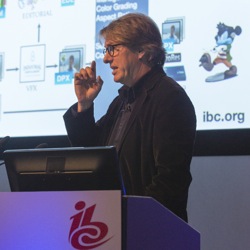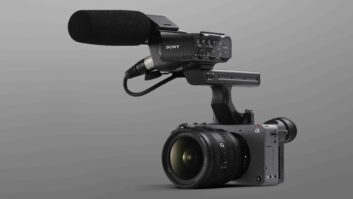
The cinema industry is exploring everything from high frame rates to 4K, immersive audio systems to laser light projection in order to create a viewing experience beyond that of the home and this includes breaking one of the taboos of cinema going: encouraging audience members to keep their mobile phone on.
“The industry’s biggest fear is that technology in the home is rising faster than the tech in the cinema,” admitted Howard Lukk (pictured), Walt Disney Studios’ vice president of production technology at IBC last month. “So how do we make the cinema experience the premium experience?”
Walt Disney has begun commercial experiments with allowing paying cinemagoers to use their phones and tablets to interact with screenings of select movies.
At select venues in the US this month the re-release of The Little Mermaid can be watched in-conjunction with an iPad app: Disney Second Screen Live. The second-screen app is synced with the movie as it is shown and encourages audience sing-alongs, game playing and viewing of additional film information.
The app has been available for home use for the past couple of years, working alongside the Blu-ray releases of The Nightmare Before Christmas, Tron: Legacy, The Lion King and Pirates of the Caribbean.
“It only works for repeat customers of a movie they have already seen,” explained Lukk. “It won’t work on new features because it’s a big distraction to other customers. I wouldn’t even consider it a theatrical experience. People love it, but they don’t come with a cinematic expectation.”
Lukk points out that for second screening to take-off, the “woefully inadequate” theatre infrastructure has to be upgraded: “Imagine the WiFi you need for 200 iPads,” he said.
Purists may shudder at the thought of auditoria lit by second screens and with tweets and other social media connections being allowed or even encouraged while a film is in play, but exhibitors are treating it with an open mind. Anything that can bring in more people – especially the younger generation – has to be worth considering.
“We are only in the foothills of our understanding about how we engage with audiences,” said Phil Clapp, president of the International Union of Cinemas (UNIC). “Exhibitors have observed a fairly monolithic business model and digital allows us to have a conversation with the audience.”
Encouragingly for exhibitors, anecdotal evidence from those attending trials of the technology is that the ability to use their devices actually enhanced their enjoyment and appreciation of that motion picture.
Could this then lead to films that are produced with such interactivity in mind? Being encouraged to Tweet or use a special second screen app during the live to cinema coverage of say, the World Cup Finals next year or even the forthcoming theatrical showing of Dr Who 3D might pay dividends.
“We have to think about product placement with databases of on-screen action linked to iPads,” said Clapp. “It’s about taking metadata out of the projector – like timecode – and creating a new participatory experience. There are some opportunities to make second screen interaction a deliberate part of cinema going.”
By Adrian Pennington







